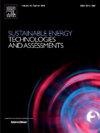Assessment of merits and demerits of perpendicular and slanted photovoltaic/thermal facades
IF 7.1
2区 工程技术
Q1 ENERGY & FUELS
Sustainable Energy Technologies and Assessments
Pub Date : 2024-10-18
DOI:10.1016/j.seta.2024.104033
引用次数: 0
Abstract
This study compares the thermal and electrical energy production potential and wind load assessment of perpendicular versus slanted photovoltaic (PV) facades. The goal is to identify the optimal facade orientation for societal adoption based on energy efficiency and wind load considerations. Using Hybrid RANS/LES models, the aerodynamic performance and energy yield of both orientations are analyzed under varying angles and environmental conditions. The findings show that while the slanted façade is better designed to capture solar irradiance, it produces 4 to 8 % less energy than the perpendicular façade and yields approximately 2 % less exergy efficiency due to wind regime. However, the slanted design reduces wind load by 9.8 %, enhancing structural stability. The maximum thermal energy output of 217 kW is recorded from the perpendicular façade at a wind speed of 1 m/s, while the slanted façade generates a peak electrical power of 68 kW at 8 m/s wind speed. Overall, the perpendicular façade underscores more efficient in equal weather conditions, making it a sustainable choice for PV installation. These results provide valuable insights for architects, engineers, and policymakers in optimizing PV facade design for urban environments.
评估垂直和倾斜光伏/热外墙的优缺点
本研究比较了垂直和倾斜光伏(PV)外墙的热能和电能生产潜力以及风荷载评估。目的是根据能效和风荷载考虑因素,确定社会采用的最佳外墙朝向。利用混合 RANS/LES 模型,分析了两种朝向在不同角度和环境条件下的空气动力性能和能量产出。研究结果表明,虽然斜面幕墙的设计能更好地捕捉太阳辐照度,但其产生的能量却比垂直幕墙少 4% 到 8%,而且由于风力的影响,其放电效率也比垂直幕墙低约 2%。不过,斜面设计可将风荷载降低 9.8%,从而增强结构的稳定性。风速为 1 米/秒时,垂直外墙的最大热能输出为 217 千瓦,而风速为 8 米/秒时,斜面外墙的峰值电功率为 68 千瓦。总体而言,垂直外墙在同等天气条件下效率更高,因此是光伏安装的可持续选择。这些结果为建筑师、工程师和决策者优化城市环境中的光伏外墙设计提供了宝贵的见解。
本文章由计算机程序翻译,如有差异,请以英文原文为准。
求助全文
约1分钟内获得全文
求助全文
来源期刊

Sustainable Energy Technologies and Assessments
Energy-Renewable Energy, Sustainability and the Environment
CiteScore
12.70
自引率
12.50%
发文量
1091
期刊介绍:
Encouraging a transition to a sustainable energy future is imperative for our world. Technologies that enable this shift in various sectors like transportation, heating, and power systems are of utmost importance. Sustainable Energy Technologies and Assessments welcomes papers focusing on a range of aspects and levels of technological advancements in energy generation and utilization. The aim is to reduce the negative environmental impact associated with energy production and consumption, spanning from laboratory experiments to real-world applications in the commercial sector.
 求助内容:
求助内容: 应助结果提醒方式:
应助结果提醒方式:


